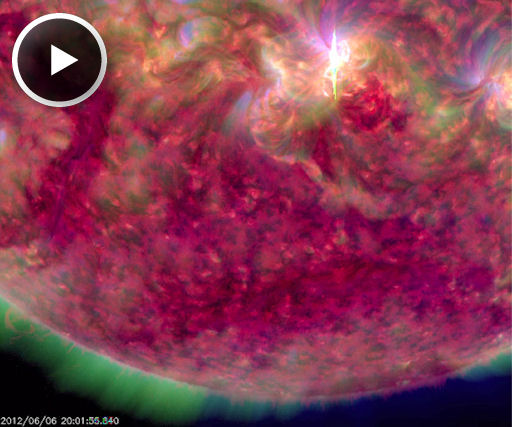SOLAR WIND: For the third day in a row, a stream of fast solar wind is buffeting Earth's magnetic field. NOAA forecasters estimate a 40% chance of geomagnetic storms around the poles on June 7th. Magnetic storm alerts: text, voice.
CHANCE OF FLARES: The odds of a significant solar flare are improving as three sunspots develop complex magnetic fields with energy for M-class eruptions. NASA's Solar Dynamics Observatory recorded this extreme ultraviolet flash (category M3) from sunspot AR1494 on June 6th:
The impulsive flare hurled a coronal mass ejection into spacce, but not directly toward Earth. The cloud should sail mostly south of our planet on June 8-9.
The other two sunspots that pose a threat for M-flares are AR1493 and AR1499. Solar flare alerts: text, voice.

![]()
Solar wind
speed: 629.5 km/sec
density: 0.1 protons/cm3
explanation | more data
Updated: Today at 1536 UT
![]()
X-ray Solar Flares
6-hr max: C2 1428 UT Jun07
24-hr: C2 1428 UT Jun07
explanation | more data
Updated: Today at: 1500 UT
![]()
![]()
![]()
Daily Sun: 07 Jun 12
![]()
![]()
Sunspot 1494 poses a threat for M-class eruptions. Credit: SDO/HMI
![]()
![]()
![]()
Sunspot number: 131
What is the sunspot number?
Updated 06 Jun 2012
Spotless Days
Current Stretch: 0 days
2012 total: 0 days (0%)
2011 total: 2 days (<1%)
2010 total: 51 days (14%)
2009 total: 260 days (71%)
Since 2004: 821 days
Typical Solar Min: 486 days
Updated 06 Jun 2012
The Radio Sun
10.7 cm flux: 140 sfu
explanation | more data
Updated 06 Jun 2012
![]()
![]()
![]()
Current Auroral Oval:
![]()
Switch to: Europe, USA, New Zealand, Antarctica
Credit: NOAA/POES
![]()
![]()
![]()
Planetary K-index
Now: Kp= 2 quiet
24-hr max: Kp= 4 unsettled
explanation | more data
![]()
Interplanetary Mag. Field
Btotal: 3.5 nT
Bz: 1.9 nT north
explanation | more data
Updated: Today at 1536 UT
![]()
![]()
![]()
Coronal Holes: 07 Jun 12
![]()
![]()
Earth is inside a high-speed stream of solar wind flowing from this coronal hole. Credit: SDO/AIA.





